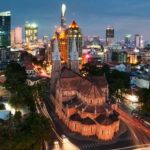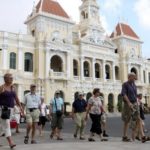“Now a tourist attraction, this massive network of tunnels on the outskirts of Ho Chi Minh City served as a base during the Vietnam War,” CNN reported.
Lying approximately 60 kilometers northwest of the center of HCMC, the Cu Chi Tunnels were utilized by Vietnamese soldiers as hiding places, communication routes, and supply lines during the war against the United States.
 |
| Inside of Cu Chi Tunnels. Photo: Vinpearl |
These tunnels were constructed in the late 1940s during the French occupation of Vietnam and endured heavy bombardment by the U.S. in the 1960s.
Besides being a bustling economic center, Ho Chi Minh City (Saigon) boasts historical relics that attract both domestic and international tourists. The Cu Chi Tunnels are one of the city’s most significant relics, offering firsthand experiences inside the extensive underground caves and providing insight into the lives of Vietnamese soldiers during the war.
Stretching to the Cambodian border, the Cu Chi tunnel system once reached nearly 250 kilometers in length, but now 120 kilometers have been preserved and are open to the public. The complex of Cu Chi Tunnels in Saigon amazes visitors with its intricate architecture and resilience in the clay soil mixed with laterite.
 |
| Inside of Cu Chi tunnels. Photo: Local Vietnam |
On the surface, there are numerous inventive booby traps and fake bunkers set up to impede and deceive enemies. The entrances to these tunnels are so narrow that only Vietnamese could fit through, with wooden manhole covers disguised by leaves.
The underground part of the tunnel system consists of three deep levels connected by numerous passages that extend to the Saigon River. The first level, located 3 meters below ground, was capable of withstanding chemical warfare, gunfire, tanks, and armored vehicles, while the second level (6 meters above ground) could withstand the destructive power of bombs. The third level is the deepest, more than 12 meters below the ground. Between the levels, there were escape hatches to counter toxic gas as well as hidden vents leading to the surface. Communication passages were constructed 0.8~1.2 meters in size with a minimum roof thickness of 1.5 meters.
A little-known fact about the Cu Chi Tunnels is that Vietnamese soldiers excavated this extensive underground network by hand using primitive tools. The inner structure of the tunnels resembles a man-made underground city, as it housed essential facilities for a thousand soldiers and residents, such as kitchens, hospitals, schools, theaters, armories, chambers, and command centers.
 |
| Photo: Klook |
These areas recreate the most intense period of the war from 1961 to 1972 in South Vietnam, providing visitors with vivid experiences as if they have traveled back in time. The site has three sections that depict the enduring lives of Vietnamese guerrilla soldiers and the local Cu Chi population during the war, as well as scenes of desolate villages destroyed by toxic chemicals, artillery, and bombing raids.
In addition to the underground experiences, the Cu Chi Tunnels offer exciting military activities that captivate many foreign tourists. Both Ben Dinh and Ben Duoc have shooting ranges where participants can handle weapons used during the war, such as AK-47s and M16s, under the guidance of staff.
In paintball shooting, players are equipped with masks, uniforms, armor, and guns for combat in the natural forest. These war simulation games allow participants to experience shooting, teamwork, and the fighting spirit of past soldiers.
 |
| The narrow entrance down to the tunnels. Photo: Beetrip |
Along with incredible historical destinations, the suburban district has become a favorite spot for rustic yet delicious cuisine. Cu Chi specialties offer pleasant flavors made from locally sourced organic ingredients that will satisfy your taste buds during your visit to the Cu Chi Tunnels.
After a long journey to the Cu Chi Tunnels, visitors are treated to jasmine tea and boiled tapioca root with a mix of salted peanuts and sugar at the Hoang Cam kitchen. This simple dish was a staple in the diet of Vietnamese fighters that helped them survive throughout the war.








